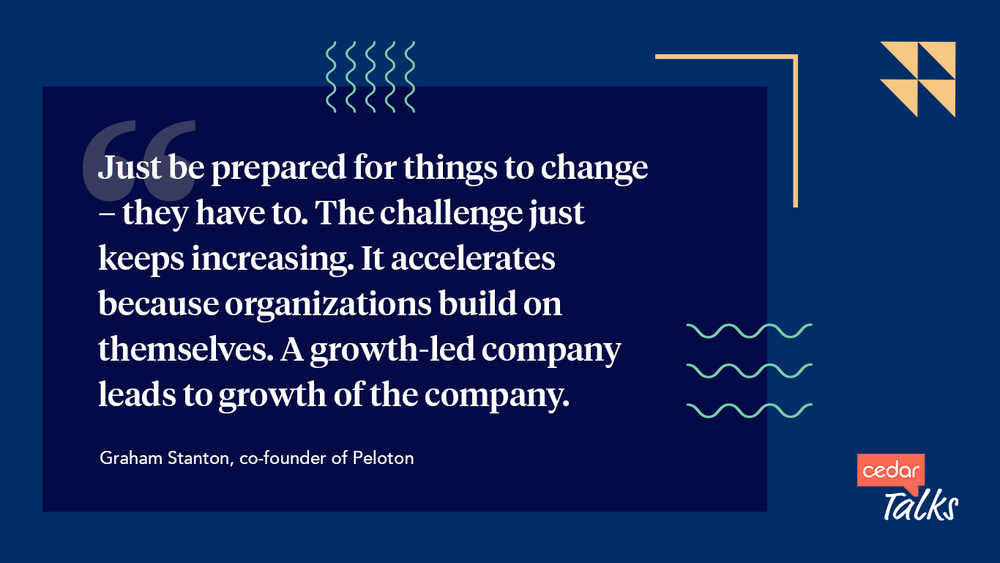Cedar recently sat down with Graham Stanton, co-founder of and current advisor to Peloton. During his time at the company, Graham started and led the Performance Marketing and Business Intelligence teams, fueling Peloton’s growth from a small startup to a digital fitness household name. During his last full-time 18 months, Graham acted as GM of Peloton Digital for its relaunch and continued leading the Business Intelligence team to overhaul all processes in advance of the company’s IPO in 2019.
Throughout the talk, Graham spoke about going from the scrappiest of startups to the world’s largest fitness tech company, fostering an engaged digital health community and using data to improve the customer experience. Peloton’s journey has amazing insights for all startups and Graham’s candid answers provide a veritable banquet of food for thought for those interested in the intersection of technology, user experience and fitness.
We’ve curated highlights of the interview below. To watch the full discussion, click here.
Peloton’s beginnings
When Peloton was first pitched to me by co-founder and CEO John Foley, my initial reaction was, “Wow. Actually that sounds really great, but are you sure that’s a big enough business for you to be involved?”
We stayed in touch. I was a seed investor in Peloton at the start. I think I was [among the] one or two people on the friends and family list. My $25,000 seed investment was like all of my savings. But I believed in the founding team and I believed in the idea and a month later, they asked if I would actually come on board and help out with this crazy idea. I didn’t hesitate. I knew the team. I knew this was something exciting. It seemed very low risk. Worst case, we build something really cool that didn’t catch on and we’d be able to move on to the next thing.
But what I didn’t foresee and certainly what the other co-founders didn’t foresee was quite how hard it would be. Really everyone had that reaction – certainly every investor – where we’d try to pitch this idea of this streaming digital content business with subscription economics and it’s really exciting. They’d just hear, “Oh, you’re making spin bikes.” And then finally they’d ask, “Wait, where does this content come from?” And we’d say, “Oh, that’s the best part. We’re opening our own spin studio.” All these software venture capitalists would kind of end the conversation right there. Thankfully the product and the service ended up beyond our wildest dreams.
Navigate to 2:37 to view the full answer here.
The initial Peloton idea & bikes
The core idea was all John. It grew out of his personal obsession with these studio cycling sessions in New York City. He and his wife were obsessed, taking a bunch. They would be on their computers at the right time slot every week for when classes opened up, and the most popular classes would fill up in the first minute or faster, suggesting a big mismatch between supply and demand. John happened to be president of e-commerce at Barnes & Noble at the time when they were launching the Nook product and he was able to kind of connect the dots on what technology can do and see this seriously unmet need.
But it was a long slog to then convince the rest of the tech community that this doesn’t sound like traditional tech […] it’s actually a really big tech opportunity. But for a while just as it was hard to raise money and it was hard to convince developers [that] ‘yes, we really are a tech company and we really are going places. No, you’re not just working for some fitness equipment manufacturer.’
For more on the formative Peloton years, check out 5:54 here.
Insisting on a great user experience and scaling up
We built it for ourselves, for our families and people we know. It was kind of an easy situation where our competition really was fitness equipment manufacturers who, at least at the time, had no idea what they were doing. And on the flip side, the tech companies were never looking at the fitness space.
On the software, we just insisted on [a great user experience] and on the hardware we found the right partners and insisted this thing can’t look like a clunky piece of gym equipment. It has to be something you’re happy to put in your living room. When we had questions without answers we just emailed 30 people and asked for feedback [laughter]. We moved quickly and we learned what we needed to do. Thankfully at the time, when we were a very small team, we didn’t feel the need to hire some consulting firm and go through a very long process for every tiny little decision.
I think for us at the beginning, it was actually very helpful that none of us had any experience with this which meant that we were really flexible and adaptable. We found the right bike manufacturer. I think it was John and an early friend of the company [who] went out to a trade show in Taiwan and looked at all the bikes and went, “This bike here has everything we need.” […] We found a design partner in New York to help come up with the look and manage that relationship […] Somehow John could convince investors that this crazy ragtag group would actually follow through and deliver on these orders.
Click here to hear more on Graham’s user-centric approach at 10:11.
Getting the word out and building a community
We ran a Kickstarter campaign which we thought would be a great initial splash. It was helpful in that it was the anchor for our original press. [But] I think we sold 188 bikes through the Kickstarter campaign.
We’d put in inquiries for where we could put little stands in high traffic areas where we thought our initial target demographic might be. We thought our initial target demographic was people who lived in houses big enough to easily have a bike, but who worked in the city. And we’ve got the indoor cycling community here, so we’re thinking Grand Central or out in the suburbs somewhere.
And we lucked out. The Short Hills Mall got in touch with us and said, “Well, we can’t really let you have a stand in the middle [of the mall], but we’ve got a really high end store where the tenant just declared bankruptcy and they’re vacating for really low rent. Would you like to move in?” And we said yes.
The community really sprang up as an independent Facebook group. We didn’t start it. It started growing rapidly. And it ended up being a really important thing for a lot of Peloton members. We actually got in touch with the founder of that group and asked if maybe they wanted it to hand it over to us and not have to manage it anymore, and they agreed.
So it became the official Peloton member group. That was started by the members finding each other. So from our standpoint, the trick turned out to be figuring out what we needed to do to support them and to support this community and allow it to grow. It was more about how to be helpful.
A lot of community building was, at least at first, reactive. Today there’s a whole team dedicated to it built up over the years. In the early days it was noticing that this Facebook group exists, so [let’s] help them out. They started organizing their own meetups, and they usually chose the local Peloton store. And so we said, “Alright, well, let’s make sure we’ve got stuff there to welcome the community.” And then we realized that people wanted to meet in stores. And maybe we could start doing some events where an instructor would show up or something like that.
We were more enabling what people are already doing organically. I think the most extreme example of that was what is now called Peloton Homecoming. A couple of years ago, thousands of people descended on New York for a very official series of events, but it was initially called the “Home Rider Invasion.”
And it literally was 20 something people flying from all over the country, going to the studio together and then showing up at our office and we gave them a little tour. [Our] small office made a scramble to figure out how to entertain them and then coordinate another one a few months later. It turned into a very official thing, but it was all leaning into what the community was already self-organizing [around].
Click here and navigate to 18:14 for the full response.
Dealing with periods of struggle
We were on exponential growth the entire time. And that certainly was a lesson. I remember having discussions with existing or potential investors in 2015 when they would say something doesn’t add up.
They would say, “We can see this product. It is amazing. You say it’s amazing – and it is! We talked to the members. They absolutely love it. The testimonials are phenomenal. But why have you sold so few bikes? Clearly you guys are doing something dramatically wrong here because you should have sold millions of these things.”
The reality was we were in the early point of the curve on exponential growth. If we were growing a few times each year, compounding growth can really make that a very big number. That’s obviously the adoption curve of the early adopters and everything, but there’s lots of stages along there. There were the people who needed to see it more established in society for a little while or needed to see their friends with it and needed to get those in-person testimonials.
Hear Graham’s full answer at 28:40 here.
Advice to growing startups: use growth as a learning opportunity
Just be prepared for things to change – they have to. The challenge just keeps increasing. It accelerates because organizations build on themselves. A growth-led company leads to growth of the company.
[When] you didn’t [have] the head of one function, [you’d] hire that person. Well, now they need a team. And now the other teams work with them and now they need to bulk up just to interact with them. Now the way the company operates needs to mature because there are so many more people and there are so many more teams. And there’s so much that you can’t have in squared interaction. So now you need more formal processes about how things actually get done. Now you’re able to hire the people who are really good at that process, which then opens new doors. The advice I’d give is take it as an opportunity to learn.
That means that everyone’s individual role changes. That usually means the day-to-day work gets narrower for most people. It’s kind of like a smaller piece of a bigger pie, but it’s even better than that because there’s the opportunity to learn from so much more of the company as a whole and of all the people around you.
I look back at my journey at Peloton and now my colleagues. The ones who really succeeded were the ones who put in all the effort to learn.
For more on Graham’s advice for growing startups, check out 38:54.
Cedar Talks is a thought leadership series focused on highlighting experienced entrepreneurs, tech innovators and healthcare leaders who are solving important problems by challenging the status quo. Recent Cedar Talks have included former President of Livongo Dr. Jennifer Schneider, venture capitalists Marc Andreessen and Scott Kupor of Andreessen Horowitz and former CEO and co-founder of Instagram Kevin Systrom. If you’d like to be notified of future Cedar Talks, click here to join the mailing list.



